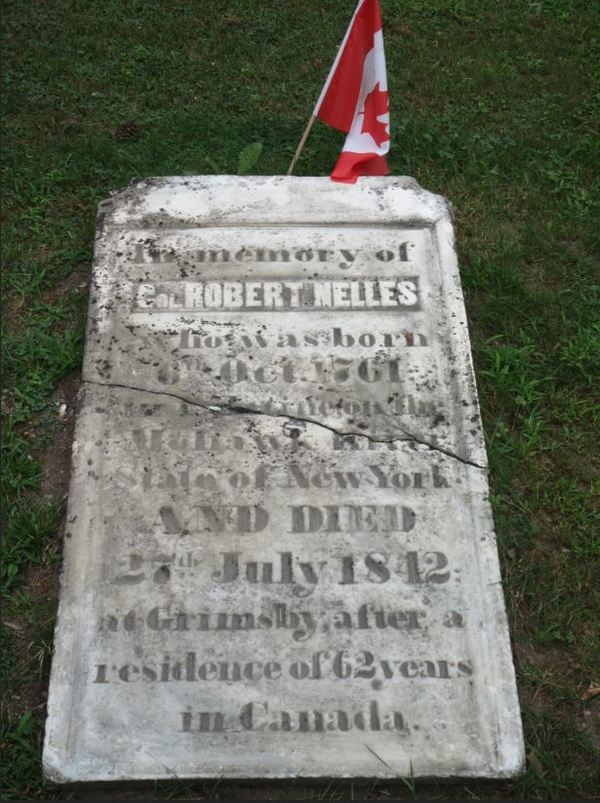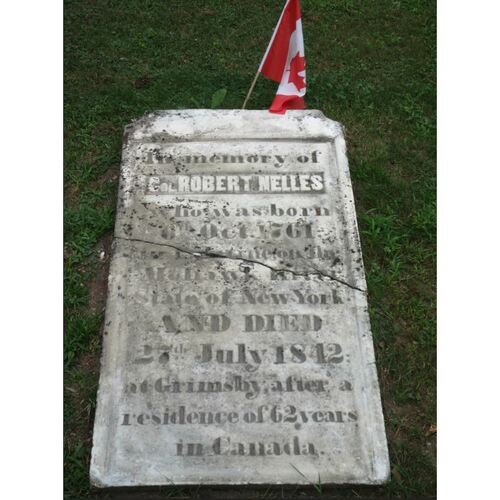
Source: Link
NELLES (Nellis), ROBERT, businessman, office holder, jp, politician, and militia officer; b. 6 Oct. 1761 in Tryon County, N.Y., eldest son of Hendrick William Nelles (Nellis); m. first 1788 Elizabeth Moore (d. 1813), and they had five sons and three daughters; m. secondly 1814 Maria Jane Waddell, the widow of Samuel Bingle, and they had two sons and four daughters; d. 27 July 1842 in Grimsby, Upper Canada.
According to family tradition, Robert Nelles was descended from a Huguenot family that was driven from France to the Palatinate (Federal Republic of Germany) following the revocation of the Edict of Nantes in 1685. In 1709 they were uprooted once again by a French invasion and found temporary asylum in England. From there they were bundled off, along with 4,000 Palatinate refugees, to populate the colony of New York. War followed them. William Nelles (Nellis), Robert’s grandfather, was pressed into taking part in an attack on New France within a year of his arrival in 1710. In 1759–60 Hendrick William Nelles, Robert’s father, served in Sir William Johnson*’s Indian Department, with which he saw action during the Seven Years’ War.
Friendship with the Indians had helped rebuild the family fortunes in New York, as it would later in Upper Canada. Abandoned by their British sponsors and denied title to their lands, the Palatinate immigrants had moved inland in the 1720s to settle among the Indians of the Mohawk valley. During the 1750s and 1760s Hendrick Nelles’s cousin George Klock was surrounded in controversy because of his method of obtaining land from the Mohawks at Canajoharie (near Little Falls, N.Y.). Klock apparently got the Indians drunk, bartered their clothes off their backs, and then tricked them into signing deeds to vast tracts of land for a pittance. Although it seems that Nelles was not involved in such deals, he certainly did acquire a great deal of land. When old associations called him back to the Indian Department in 1777 (or revolutionary tensions drove him back), he left behind property that he later valued at £3,760, not counting stock and equipment.
After 1777 the Indian Department strategy was simply to destroy the settlements in the interior of New York that supplied the Continental Army. Captain Nelles (he anglicized his name to Henry at this time) accompanied Indians on many savage raids back into his own Mohawk valley, sacking homesteads, burning crops, and killing and scalping settlers. Through his intervention the Old Palatine Church, which his family had helped build, and the Nelles homestead were spared destruction. On one of these murderous missions in 1780 Nelles “recovered” his teenage son Robert, who joined him at Fort Niagara (near Youngstown, N.Y.) as a lieutenant in the Indian Department. Robert proved as energetic and resourceful at frontier terrorism as his father, leading raids in 1781 and 1782 with a cool fury. He returned in modest triumph from the 1782 campaign with “a parcel of negroes & wenches” in tow, for which he found a ready market in Niagara. At the end of the war, both Robert and his father were released from the Indian Department, but were retained on half pay.
Understandably, neither father nor son returned after the war to the district that they had razed. Instead, they followed their Indian clients to the Grand River valley, where they settled and did a little fur trading. In February 1787 Joseph Brant [Thayendanegea*] arranged for some 4,254 acres on the Grand River to be deeded to Henry Nelles and his sons Robert and Warner “to be possessed by them and their posterity.” By the time of Henry Nelles’s death in 1791, five of his sons were settled in Upper Canada. The Nelleses received other land grants for military service, loyalism, and compensation for lost property, and by 1800 they collectively owned 7,300 acres, most of it in the Niagara District, making them the sixth largest landholders on the peninsula.
Robert decided to develop more than 600 acres on Forty Mile Creek. There, on the site of present-day Grimsby, he built mills and a store, and commenced a grand stone mansion, The Manor, which still survives. In the 1790s he supplied hardware, household goods, textiles, and provisions to the small settlement. After 1800 he forwarded whiskey, grain, and flour from his mill to W. and J. Crooks at Niagara (Niagara-on-the-Lake) [see James Crooks*]. Joseph Brant sought his help both in supplying the Six Nations settlements and in the education of his own sons. Robert was also briefly pressed into service again as an Indian agent in 1797, delivering trade goods to the Mississauga Ojibwas under the terms of their recently concluded treaty. Thus Robert Nelles launched his own family from the elevated position accorded by landed wealth, a commercial income, and his continuing half pay.
Being a local notable in a deferential society, Nelles held various offices, such as town warden and justice of the peace, and was inevitably drawn into provincial politics. In the 1800 general election he headed the poll in the two-member riding of York West, 1st Lincoln, and Haldimand and he served in the House of Assembly until 1808, usually voting with the government majority. He seems to have devoted himself to local appropriations and regularizing the title to family land on the Grand River. While he was away at York (Toronto), his brothers, and later his eldest son, Henry, looked after the store and mills, and his wife, Elizabeth, tended a growing family that eventually numbered eight children.
War threatened life and property again in 1812 and Nelles, his brothers, and his son responded to the call to arms. Robert reported for duty as a captain in the 4th Lincoln Militia in 1812 but did not see much action during the next two years. The inhabitants of the Niagara District, many with loyalties cruelly divided by the war, seemed to prefer being spectators. The local militia remained inactive, undermanned and demoralized, especially after the American occupation in 1813. This state of affairs led to a general shake-up of command in the Lincoln militia in 1814 during which Nelles was promoted lieutenant-colonel of the 4th regiment. He quickly brought it up to strength with threats of fines and courts martial. Robert and his family fought in several battles, most notably at Lundy’s Lane, where his son was captured and his brother wounded.
After the war he remarried and briefly returned to public life. In February 1814 he had been elected to the assembly for 1st Lincoln and Haldimand to replace the expelled Joseph Willcocks*. He held the seat until 1820; while he attended parliament, his son Henry managed the family mills. This separation has bequeathed to us a rare collection of touching love-letters between husband and wife. Robert Nelles (over the years the spelling gradually regularized to Nelles) was enormously proud of his military record and continued to take a great deal of interest in militia affairs. In 1822 he was rewarded with a promotion to colonel of his regiment. He scandalized and angered his neighbours with the unblushing favouritism of his appointments. For 20 or more years most of the officers in his regiment were members of the Nelles family. This situation aroused jealousy and resentment not only in the county but also within the Nelles family. In 1822 Robert promoted his son-in-law, but his brother William claimed seniority and marred the annual militia parade by beating his rival with a stick.
Robert Nelles’s sons were all well educated by the standards of the day. They received an elementary education in a school their father had established at the Forty (Grimsby), and some of them were sent to York to continue their training in the care of the Ridouts and John Strachan*. Although raised a Lutheran in the German-speaking Palatinate community in New York, Robert helped build and became a pillar of the Anglican church in Grimsby. His son Abram* became a noted Church of England missionary to the Six Nations Indians. This appointment served to mark the great change that had taken place over the generations in the relative fortunes of the Nelles family and their Indian neighbours. Abram, a professional man from a well-off family, ministered to the poor and confined population of a reservation, descendants of the warriors his father and grandfather had fought alongside in three wars, whose friendship had so generously endowed the family with land.
AO, MS 118; MS 502; MS 503; MU 3296. BL, Add. mss 21661–892 (mfm. at PAC). HPL, File information on Robert Nelles. PAC, MG 19, Fl; F2; F6; MG 24, D108; RG 9, I, B1; B34; B35; RG 10, A1; RG 19, E5(b), 4447. The papers of Sir William Johnson, ed. James Sullivan et al. (14v., Albany, N.Y., 1921–65). U.C., House of Assembly, Journal, 1800–10, 1816–20. Valley of Six Nations (Johnston). D. C. Nellis, [Nellis family album] (Topeka, Kans., 1888; copy in possession of H. V. Nelles). William Gillard and Thomas Tooke, The Niagara escarpment: from Tobermory to Niagara Falls (Toronto and Buffalo, N.Y., 1975), 100, 104. Barbara Graymont, The Iroquois in the American revolution (Syracuse, N.Y., 1972). [L. D. MacWethy and] Milo Nellis, The old Palatine church, together with a description of the Gen. John Cochran house, also articles on the early Klock and Nellis pioneers ([3rd ed.], St Johnsville, N.Y., 1930). Milo Nellis, The Mohawk Dutch and the Palatines; their background and their influence in the development of the United States of America (St Johnsville, [1951]). B. G. Wilson, Enterprises of Robert Hamilton. E. A. Brooks, “The story of William Sampson, first rector of Grimsby, 1817–1822,” Wentworth Bygones (Hamilton, Ont.), no.11 (1975): 28. “The coming of the loyalists, 1783–1787” and “Fifty years of municipal government, 1790–1840,” comp. R. J. Powell, Annals of the Forty ([Grimsby, Ont.]), no.1 (1950): 4–7, 32–35, 88, and no.2 (1951): 12. H. V. Nelles, “Loyalism and local power: the district of Niagara, 1792–1837,” OH, 58 (1966): 99–114. J. G. Rossie, “The Northern Indian Department and the American revolution,” Niagara Frontier (Buffalo), 20 (1973): 52–65.
Cite This Article
H. V. Nelles, “NELLES (Nellis), ROBERT,” in Dictionary of Canadian Biography, vol. 7, University of Toronto/Université Laval, 2003–, accessed December 20, 2025, https://www.biographi.ca/en/bio/nelles_robert_7E.html.
The citation above shows the format for footnotes and endnotes according to the Chicago manual of style (16th edition). Information to be used in other citation formats:
| Permalink: | https://www.biographi.ca/en/bio/nelles_robert_7E.html |
| Author of Article: | H. V. Nelles |
| Title of Article: | NELLES (Nellis), ROBERT |
| Publication Name: | Dictionary of Canadian Biography, vol. 7 |
| Publisher: | University of Toronto/Université Laval |
| Year of publication: | 1988 |
| Year of revision: | 1988 |
| Access Date: | December 20, 2025 |



